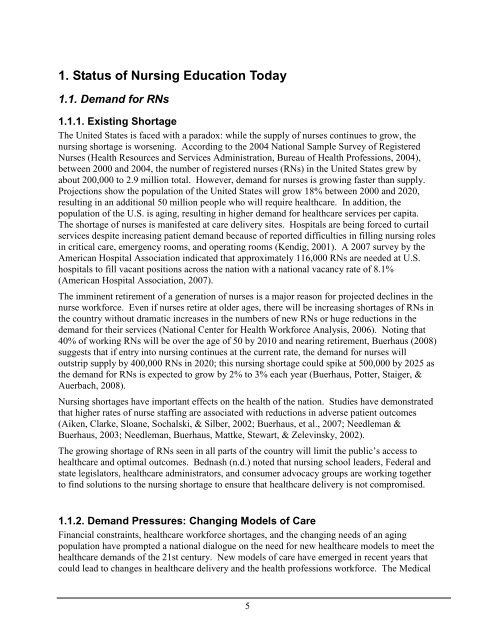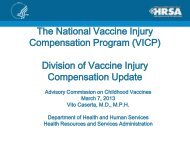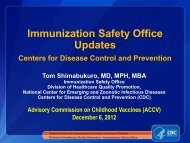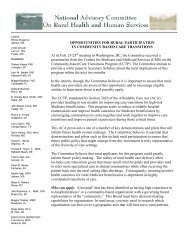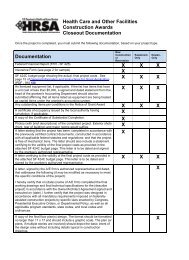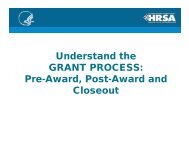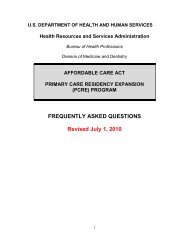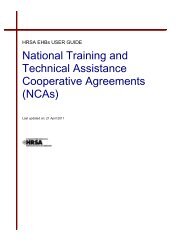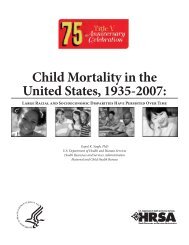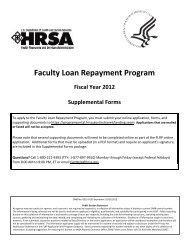Addressing New Challenges Facing Nursing Education ... - HRSA
Addressing New Challenges Facing Nursing Education ... - HRSA
Addressing New Challenges Facing Nursing Education ... - HRSA
Create successful ePaper yourself
Turn your PDF publications into a flip-book with our unique Google optimized e-Paper software.
1. Status of <strong>Nursing</strong> <strong>Education</strong> Today<br />
1.1. Demand for RNs<br />
1.1.1. Existing Shortage<br />
The United States is faced with a paradox: while the supply of nurses continues to grow, the<br />
nursing shortage is worsening. According to the 2004 National Sample Survey of Registered<br />
Nurses (Health Resources and Services Administration, Bureau of Health Professions, 2004),<br />
between 2000 and 2004, the number of registered nurses (RNs) in the United States grew by<br />
about 200,000 to 2.9 million total. However, demand for nurses is growing faster than supply.<br />
Projections show the population of the United States will grow 18% between 2000 and 2020,<br />
resulting in an additional 50 million people who will require healthcare. In addition, the<br />
population of the U.S. is aging, resulting in higher demand for healthcare services per capita.<br />
The shortage of nurses is manifested at care delivery sites. Hospitals are being forced to curtail<br />
services despite increasing patient demand because of reported difficulties in filling nursing roles<br />
in critical care, emergency rooms, and operating rooms (Kendig, 2001). A 2007 survey by the<br />
American Hospital Association indicated that approximately 116,000 RNs are needed at U.S.<br />
hospitals to fill vacant positions across the nation with a national vacancy rate of 8.1%<br />
(American Hospital Association, 2007).<br />
The imminent retirement of a generation of nurses is a major reason for projected declines in the<br />
nurse workforce. Even if nurses retire at older ages, there will be increasing shortages of RNs in<br />
the country without dramatic increases in the numbers of new RNs or huge reductions in the<br />
demand for their services (National Center for Health Workforce Analysis, 2006). Noting that<br />
40% of working RNs will be over the age of 50 by 2010 and nearing retirement, Buerhaus (2008)<br />
suggests that if entry into nursing continues at the current rate, the demand for nurses will<br />
outstrip supply by 400,000 RNs in 2020; this nursing shortage could spike at 500,000 by 2025 as<br />
the demand for RNs is expected to grow by 2% to 3% each year (Buerhaus, Potter, Staiger, &<br />
Auerbach, 2008).<br />
<strong>Nursing</strong> shortages have important effects on the health of the nation. Studies have demonstrated<br />
that higher rates of nurse staffing are associated with reductions in adverse patient outcomes<br />
(Aiken, Clarke, Sloane, Sochalski, & Silber, 2002; Buerhaus, et al., 2007; Needleman &<br />
Buerhaus, 2003; Needleman, Buerhaus, Mattke, Stewart, & Zelevinsky, 2002).<br />
The growing shortage of RNs seen in all parts of the country will limit the public’s access to<br />
healthcare and optimal outcomes. Bednash (n.d.) noted that nursing school leaders, Federal and<br />
state legislators, healthcare administrators, and consumer advocacy groups are working together<br />
to find solutions to the nursing shortage to ensure that healthcare delivery is not compromised.<br />
1.1.2. Demand Pressures: Changing Models of Care<br />
Financial constraints, healthcare workforce shortages, and the changing needs of an aging<br />
population have prompted a national dialogue on the need for new healthcare models to meet the<br />
healthcare demands of the 21st century. <strong>New</strong> models of care have emerged in recent years that<br />
could lead to changes in healthcare delivery and the health professions workforce. The Medical<br />
5


